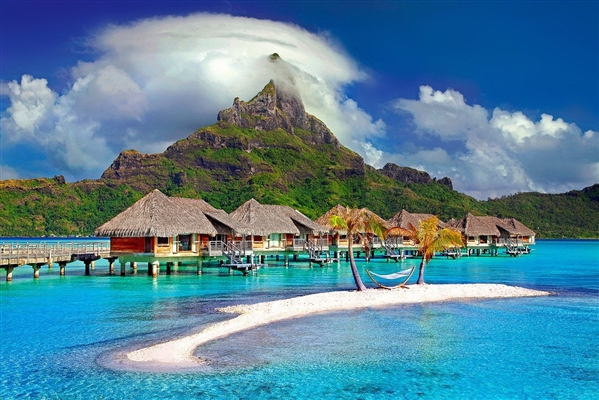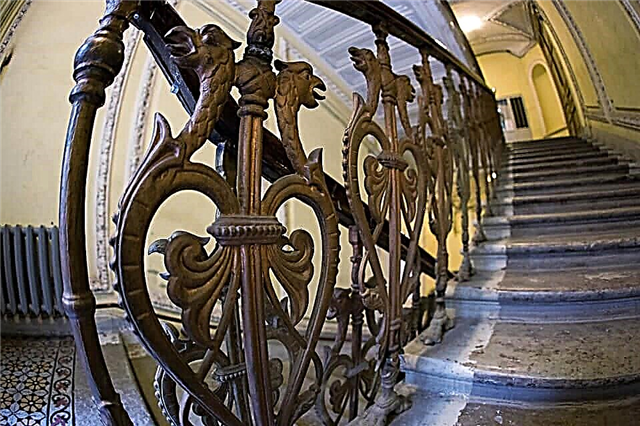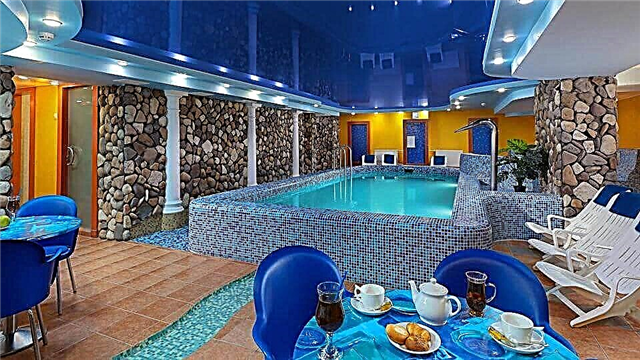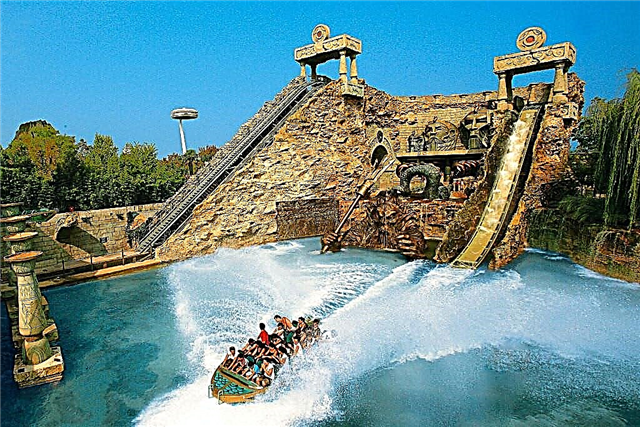Unlike most of the sights of Kostroma, the Nativity of Christ Church, which is often called Ilyinsky by the aisle, stands on the right bank of the Volga. These places were owned by the boyar Gleb Ivanovich Morozov, whose wife, the famous preacher of the Old Belief, is depicted on the famous canvas of V.I. Surikov's "Boyarynya Morozova". The stone church witnessed the tragic events of the church schism in Russia and went through a difficult time of the anti-religious campaign of the 20th century. Today this ancient temple is included in the popular routes of the "Golden Ring" of Russia.
Church history
The picturesque and majestic temple has stood on the Trans-Volga side of Kostroma for over 350 years. Historians are sure that the ancient city was originally located here, on the right bank of the Volga. And only after the invasion of Batu Khan's troops (1238), people moved to the opposite bank of the river.

View of the church from the side of Dachnaya street
In former times, the temple was the parish church of the village. The settlement, as a family patrimony, belonged to the noble and wealthy boyar Gleb Ivanovich Morozov. After his death, the Kostroma settlement was inherited by the boyar's widow - Feodosya Prokofievna (nee Sokovnina), who later became an associate of the disgraced supporter of the Old Believer faith, Archpriest Avvakum.
The brick church on a high hill above the Volga was built by the Morozovs in 1649-1652. And the reason for the expensive stone construction, most likely, was the boyar's marriage to the seventeen-year-old Feodosia Prokofievna Sokovnina. Morozov's first marriage, which lasted about 30 years, turned out to be childless. Having become a widow, the rich boyar decided to marry again and had high hopes for a new family union. Since 1663, the new church is first mentioned in the chronicles as functioning.

View of the three-arch gate with a fence in the background of the church
Archaeologists working at the base of the hill fortified settlement, based on the finds, suggested that the brick temple was most likely preceded by a wooden one, which burned down during a fire in the middle of the 17th century. The brick Nativity of Christ Church became the first stone church built on the Zavolzhskaya side. It had five chapters and two side-altars - Ilyinsky and Feodosia. It is known that boyar mansions made of wood stood nearby.
During the church schism, after a conflict with the tsar, arrest and deprivation of the name of the boyarynya Morozova, she was exiled to the Borovsk monastery and imprisoned in a prison. There the disgraced Old Believer died of hunger in 1675. The only son of the Morozovs outlived his mother by only 3 years and died at the age of 20. After that, the Settlement, like other Morozov possessions, were recognized as escheat estates, in which there were no heirs. And they were written off to the sovereign's treasury.

Icon on the three-arch gate
The first restructuring of the Nativity of Christ Church began when the boyar clan Khitrovo began to own the Settlement. First, the north side-chapel was dismantled and the composition of the bell tower was complicated. The destruction of the Feodosia side-chapel was most likely carried out to erase the memory of the disgraced boyar. After her death, the Old Believers venerated the places associated with the widow of Morozov, and continued to actively visit the city church and pray for the soul of the deceased boyar. They did not dare to officially prohibit such a pilgrimage. But the new church did not want to put up with him, and the chapel dedicated to Morozova was dismantled to the ground. Researchers suggest that this happened in 1683.
Later, four side chapters were removed from the church. In the 1820s, most of the top of the hill fort was surrounded by a stone fence, which became an organic part of the entire temple ensemble. In the western part of this fence, a beautiful three-arched gate with domes was erected.

View of the south facade of the church
The church on the hill looked very picturesque, and these places have always attracted many artists and writers. The Nativity of Christ Church greatly impressed the young A.N. Ostrovsky. And the sketches created by the artists G.G. and N.G. Chernetsovs, along with photographs of the early 20th century, later served as excellent material for restoration and restoration work.
The new Soviet government did not close the church immediately, but only in 1936. And in the early 1930s, all the bells were defiantly thrown off the church bell tower. The larger bell could not be pulled through the arched opening, and the workers barbarously broke the edge of the brickwork. In 1941, a decree was issued to demolish the church, but the outbreak of war changed plans. Later, grain warehouses were located in the cult building. But most of the time this remarkable architectural monument stood in desolation and was destroyed. In the 1950s, the churchyard was destroyed and the church fence was finally dismantled, leaving only the gate. It was planned to build a park on the former churchyard, but the place remained abandoned and unkempt.

View of the southeastern facade of the church (chapel of Elijah the Prophet)
The restoration of the temple began in 1986, and the architect L.S. Vasiliev. Initially, it was planned to place museum collections in the church, but after 4 years it was returned to believers.
Architecture and interior decoration
In the 17th century, the temple building looked different. Initially, a five-domed two-pillar church was built, which was surrounded by a gallery on three sides. The main quadrangle was adjoined by two chapels - the Prophet Elijah and the Monk Martyr Theodosia of Constantinople. Small adjoining churches did not have altar apses, but were crowned with their own domes. And to the west of the temple complex there was a low tent-roofed bell tower.

From left to right: bell tower, Church of the Nativity of Christ, chapel of Elijah the Prophet
Today the temple has one dome and a four-pitched roof, from which the old podzakomarny covering was replaced. Surprisingly, alterations, usually disfiguring the architectural appearance of buildings, have made the fortified temple more majestic. Thanks to new forms, it is a laconic completion of the hill on which it is located, and attracts the eyes of travelers and pilgrims.
The decoration of the facades of the temple is in keeping with the traditions typical for the religious buildings of Kostroma of the early and mid-17th century. The corners of the quadrangle go around graceful shoulder blades. Small windows of the main volume are recessed into niches. A picturesque arcature-columnar belt runs along the facade. The altar window openings are more decorative. Their platbands are decorated with triangular and keeled pediments, and from the south - with a picturesque multi-bladed kokoshnik.

Interesting finds have been made by restorers during recent restoration work. They found that many clay pots were built into the brickwork of the upper sections of the walls of the temple. Such inserts were called “voice-overs” and served to improve the acoustics inside the temple.
The current state of the temple and the visiting regime
The church is active and has the status of a cultural heritage site of federal significance. A Sunday school is open at the church for the children of parishioners. Anyone can get inside the church.

How to get there
The temple is located on the street. Dachnaya, 17a.
By car. The road from the capital to Kostroma takes 4.5-5 hours (346 km) and runs along the Yaroslavl highway and the M8 highway (Kholmogory). In Kostroma, before reaching the road bridge across the Volga, in front of the RIO shopping center you need to turn left onto Zavolzhskaya street. Drive 1.25 km along it and turn right - onto st. Yuri Belenogov. After 1 km, this street will lead to Dachnaya street, on which the temple is located. He stands on the right along the course, 90 m from the intersection of ul. Country house and st. Yuri Belenogov.

By train or bus. From the Yaroslavsky railway station to Moscow trains reach Kostroma in 6.04-6.35 hours.In addition, from the Central Bus Station of the capital, located near the Shchelkovskaya metro station, you can get to Kostroma by regular buses (7 trips a day). This journey takes 6.50 hours. The Kostroma bus station is 1 km away from the railway station. You can drive up to the temple in the city by bus or minibus number 20 (stop "Belenogova Street"), and then walk 0.3 km. Or use a taxi.
Attraction rating:











